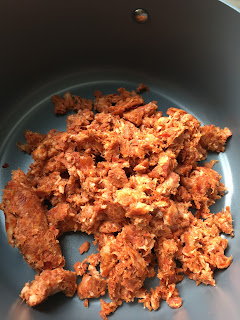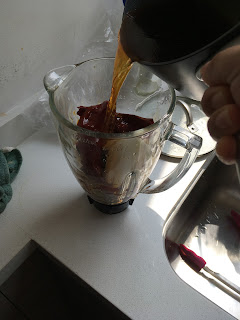Years ago, right after my mission, (so, around 2009), I decided to start my personal collection of reconstructed/replicated historical clothing. Somehow, I fell in with the market women of the 16th century Netherlands and fell down the rabbit hole of roiling controversy concerning how their clothing was constructed. Two examples of Joachim Beuckelaer's paintings, "Market Woman" and "Kitchen Scene", respectively:


I picked a side in the construction debate and made two gowns according to the stomacher/no-kirtle construction method, one in mauve summer-weight wool and one in blue linen. I really liked them, but they are falling apart, mainly, I think, due to the fabric I used. I should have used **real** wool, something fulled a bit, something that doesn't ravel when cut, something that has a lot of body and structure on its own. Also, I really got frustrated dealing with the stomacher issue. It was annoying to hold in place while trying to lace it down. I probably just should have pinned it to my shift, but whatever, I wasn't thinking clearly.
 |
This is me wearing my awesome new handsewn garb to my first SCA event ever, sometime before Pennsic 2010.
No idea who this photo came from.. |
I *just* re-found some images that a friend of mine (yay Janna Wilkinson Mayo!!) took way back in February of 2011. I'm pretty sure I had gone to my first Pennsic in 2010.. Pretty sure. Anyway, since these have never seen the light of day (I didn't like my haircut, but now I don't care!), I'm going to air them here!! The lighting in this building wasn't great, hence some of the blurriness, but you get the idea!
 |
| I just need some fruits and veggies and I could be a market woman! |
 |
| blurry, but I LOVE the pleats!! |
 |
| I have since gotten cooler shoes than these China Town dealios. And I think I hemmed the apron shorter. |
 |
| The partlet is pinned in the middle. |
 |
| I kinda jerry-rigged the partlet to tie on almost invisibly with ties and loops, which is an entirely unprovable method, except that pins sounded annoying and one theory had it that the stress wrinkles in the pictures supported a tied-on theory, even though no pictures show any ties. They don't show any pins either. Neither does mine! (That dangly tie in the front is my bodice lacing.) |
 |
The head-wrap is definitely out of time and place, but it is quick and easy!
I have since made myself a good coif, and I want to make a wired one this summer too! |
So. This was my first truly researched and hand-sewn garb for myself that I ever made! Still pretty proud of it.
Now I find myself with some really nice wool on hand, wanting to make a new version of this gown. And in re-researching, I find myself back in that mire of contradictory evidence and opinions, where everyone puts forth their own theory and proves that it is correct. I would like to do the same, but I have perhaps a unique position to posit:
I think everyone* is right.
Let me explain.
Drea Leed is kind of the first garber who decided to figure these ladies out, so I owe this blog post to her :) She looks at the evidence and says that there is definitely structure and maybe some boning to the edges of the gown because we can see stretch wrinkles while the edges of the lacing remain straight. Also she says there is a tightly fitted kirtle underneath the gown, giving support. And she says that sometimes the gown's skirt is split. Well, here, the evidence is before our eyes:
Stretch lines around the waist of the gown, a stiff-looking bodice with no boobs hanging out, and a split skirt that is pinned up at the back! These images all support Leed's thesis.
(Beuckelaer, Egg Seller 1565/Beuckelaer, The Four Elements: Fire detail 1570/Beuckelaer, Market Scene with Ecce Homo detail 1566)
Then there is the
Kass McGann method, which I subscribed to in 2009. She points to pictorial evidence that contradicts Leed and says: Look! All these curvy boobs are bulging out all over the place, there is no way that there is a fitted kirtle going on under this outer gown! And all these floppy flaps of fabric can't possibly be fitted kirtles!
And the pictorial evidence obliges and shows us some pretty bulgy boobs:
 |
A sideways view on the left and a bird's eye view in the middle!
Aertsen, Market Scene with Christ and the Adultress, 1559 |
and some pretty floppy stomachers:
 |
See the woman on the left.
Beuckelaer, Allegory of Carelessness c. mid 1500's |
 |
Woman mid left, with the red floppy thing over her busom.
Beuckelaer, The Four Elements: Water 1569 |
(McGann points out other details that corroborate her construction method as well, which seem pretty convincing to me, such as square-cut sleeve holes, and skirts that are shorter in the front, but I'll leave her most obvious arguments to speak for themselves. And bring those details up later, when I'm actually deciding what to sew this time around.)
Another researcher,
Aliet, points to a booming second-hand market in Dutch cities at the time and suggests that McGann's focus on using the least fabric possible was not a relevant concern to the wearers of the gowns, since they were likely not the makers of them (which is an amazing application of social history research to garment construction!!). She still uses McGann's gown construction method, though she explains away the stomacher evidence as either too-big ready-made kirtles or the fabric of the apron held under the lacing. She espouses the Leed idea of a separate kirtle underneath but disagrees with Leed in the split-skirt department.
Morgan Donner, on the other hand, questions the idea of a kirtle underneath the gown because in her image research she has never seen the shoulder straps of another layer peeking out. She also introduces another element to the debate with this painting, which struck me as soon as I came across it on pinterest:
 |
One troublesome issue with using this painting as evidence is the subject: peasants.
The market women we've been talking about were urban, not rural.
Martin Van Cleve, Peasant's Wedding detail 1550's |
Donner suggests that it could be showing either a "stomacher" built into the gown and lined in blue, OR a separate stomacher draped over the opening of the gown. (and I say, why not have a gown with a different colored stomacher sewn on to it!! You'd have to add fabric above the skirt anyway and it eliminates the problem of how to close the gown below the lacing while still fitting with all the different color bellies we see!!)
In the end her recreation of this gown uses a pinned on stomacher under the gown, and she opts to wear a boned pair of bodies underneath the ensemble to get enough support. But thankfully she decided to show us what different amounts of support would look like in her post
here, and I love what she finally concluded:
"As far as I can see, all three work depending on which paintings I compare it to."
I think, in the end, this is the closest to the truth. All of the women in the paintings surely had different levels of income (working as they do in brothels, kitchens, and markets), and different requirements on the appearance vs utility of their clothing and bodies (ditto). Some, as McGann suggests, possibly made their own gowns. Some, as Aliet suggests, probably bought them on the second-hand market. The questioning of boning in the 16th century is still really up in the air, but supporting one's bosom comfortably (whatever that means to the individual) was likely always a concern. And then again, a similar type of garment can look completely different on different body types!
(As an immediate example, look at the pictures of me from 2011 above. My bodice looks pretty smooth and fitted, but I think that is mainly because of my shape and size. I don't have big boobs, so no big boobs were straining at my partlet. One might see those photos and deduce that I was wearing a supportive garment underneath, but I wasn't.)
These working woman paintings do share an overall clothing style throughout, but the details start to vary wildly once you get up close and personal. I have decided that I support all of the theories! They all do seem right, depending on which painting you are comparing it to!
As for me and my garb...now that might be another story.
For another day. :)
*No, not Joe Schmoe on the street! Everyone in the garbing community who has a theory based on the evidence!!















































